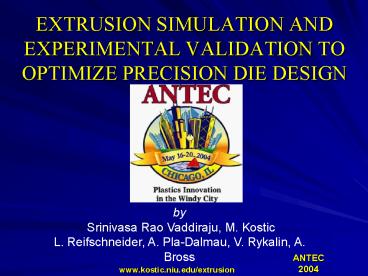EXTRUSION SIMULATION AND EXPERIMENTAL VALIDATION TO OPTIMIZE PRECISION DIE DESIGN - PowerPoint PPT Presentation
1 / 27
Title:
EXTRUSION SIMULATION AND EXPERIMENTAL VALIDATION TO OPTIMIZE PRECISION DIE DESIGN
Description:
... $40/kg Extruded plastic scintillator ... with Scintillator dopant additives Carreau-Yasuda Law for viscosity data: Measured by, Datapoint Labs, ... – PowerPoint PPT presentation
Number of Views:564
Avg rating:3.0/5.0
Title: EXTRUSION SIMULATION AND EXPERIMENTAL VALIDATION TO OPTIMIZE PRECISION DIE DESIGN
1
EXTRUSION SIMULATION AND EXPERIMENTAL VALIDATION
TO OPTIMIZE PRECISION DIE DESIGN
by Srinivasa Rao Vaddiraju, M. Kostic L.
Reifschneider, A. Pla-Dalmau, V. Rykalin, A.
Bross
2
Introduction
- Twin-screw extrusion line
- Fermi National Accelerator Laboratory (FNAL)
- Northern Illinois Center for Accelerator and
Detector Development (NICADD) - Department of Mechanical Engineering
Cast plastic scintillator - 40/kg Extruded
plastic scintillator - 10/kg
3
Profile Extrusion Line at FNAL
- Berstorff 40-mm diameter, 1.36 m long, twin-screw
extruder - Two K-Tron automated feeders
- Conair downstream equipment
- Novatec compressed-nitrogen drier
Polymer pellets
Dopants
Dryer
Feeding
Hopper
Breaker plate
Cooling
Haul-off
Die
Cutter
Gear pump
Extruder
Calibrator
Measurement
4
Required Extrudate profile
All dimensions are in cm
0.11
1.0
2.0
Rectangular cross section of 1 cm ? 2 cm with a
circular hole of 1.1 mm diameter at its center,
to accommodate wavelength-shifting optical fiber.
5
Typical extrudate sample profile
6
Objectives
- Effective die design strategy
- Die swell and optimum die profile-shape
- Flow and heat transfer Simulation
- Integrate the simulation results with the
experimental data
7
Polyflow?
- Finite-element CFD code
- Three-dimensional free surfaces
- Inverse extrusion capability
- Strong non-linearities
- Evolution procedure
8
Flowchart for Numerical Simulation
1. Draw the geometry using a CAD software
2. Mesh the geometry
3. Specify Polymer properties and boundary
conditions
Modify the mesh
4. Specify remeshing technique, solver method and
evolution parameters
Modify remeshing techniques, solver methods
and/or evolution parameters
5. Solver solves the conservation equations using
the specified data and boundary conditions
6.Is the solution converged?
No
Stop
Yes
9
General Assumptions
The flow is steady
and incompressible
Body forces and Inertia effects are negligible
in comparison with viscous and pressure forces.
Specific heat at constant pressure, Cp, and
thermal conductivity, k, are constant
10
Material Data
Styron 663, with Scintillator dopant additives
Measured by, Datapoint Labs, NY
Carreau-Yasuda Law for viscosity data
NOTE Viscoelastic properties were neglected in
our simulation
11
Styron viscosity data, with and without
Scintillator dopants
Viscosity (Pa-s)
106
? Styron 663 ?d Doped Styron 663
105
180 0C
200 0C
220 0C
104
103
102
100
10-2
101
10-1
103
102
12
Exploded view of the extrusion die
13
Half domain of the extrusion die
14
Simulation domain with boundary conditions
1
- . Inlet (Fully Developed Flow)
- 2. Wall (Vn 0, Vs 0)
- 3. Symmetry (Vn 0, Fs 0)
- 4. Free Surface (Fs 0, Fn 0, V.n 0)
- . Outlet (Fn 0, Vs 0)
15
Finite element 3-D domain and die-lip mesh
30,872 elements Skewness lt 0.33
Melt flow direction
Die Lip
16
19 hours and 36 minutes of CPU time
Computation time
- Windows XP
- 2.52 GHz Processor
- 1 GB RAM
Parametric Studiespreland and dieland, much
faster
17
Contours of static pressure
18
Contours of velocity magnitude at different
iso-surfaces
19
Contours of temperature distribution
20
Contours of shear rate
Die lip
Melt flow direction
21
Existing die, corresponding simulation and new
improved-die profiles
New Die (Simulated)
Existing Die
Y (mm)
Desired Extrudate
Existing-Die Extrudate (Simulated)
X (mm)
22
2 D-View of the extrusion die
Melt flow direction
23
Conclusions
- Optimum dimensions of the die
- Effect of inertia terms negligible
- Exponent of the Carreau-Yasuda model -
significant effect - Flow in the die no re-circulation regions
24
Recommendations for future improvements
- Include polymer viscoelastic properties
- Include cooling, solidification and
thermo-mechanical stresses in and after the
calibrator - Radiation heat transfer for free surface flow
- Pulling force at the end of the free surface
- Nitrogen pressure inside the hole
- More non-uniform mesh
25
Acknowledgements
- NICADD (Northern Illinois Centre for Accelerator
and Detector Development), NIU - Fermi National Accelerator Laboratory, Batavia,
IL - NIUs College of Engineering and Department of
Mechanical Engineering
26
QUESTIONS ?
27
Contact Information
- mailto kostic_at_niu.edu
- www.kostic.niu.edu
- mailto vaddirajs_at_yahoo.com
- www.vaddiraju.com





























![Modeling MEMS Sensors [SUGAR: A Computer Aided Design Tool for MEMS ] PowerPoint PPT Presentation](https://s3.amazonaws.com/images.powershow.com/4532729.th0.jpg?_=20200927124)

